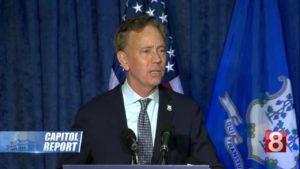Figuring out the state”™s Covid vaccine strategy, refocusing on workforce development ”“ and promising no tax hikes ”“ Gov. Ned Lamont characteristically provided a relatively upbeat forecast for Connecticut during the CBIA”™s annual Economic Summit and Outlook this morning.
 Noting that Europe in particular is currently facing the challenges posed by the new, highly infectious strain of Covid-19 (the state so far has recorded four cases of the Covid-19 variant B.1.1.7), and that various countries there have, or are considering, the institution of renewed lockdowns, Lamont said, “I certainly don”™t want that in Connecticut.”
Noting that Europe in particular is currently facing the challenges posed by the new, highly infectious strain of Covid-19 (the state so far has recorded four cases of the Covid-19 variant B.1.1.7), and that various countries there have, or are considering, the institution of renewed lockdowns, Lamont said, “I certainly don”™t want that in Connecticut.”
The state has “done pretty well when it comes to the vaccine,” the governor said, noting that Connecticut this week received an extra 50,000 doses from the federal government.
“That is the stumbling block right now ”“ getting the vaccines,” he said. The state has the capacity to administer “five times” the 50,000 weekly doses it now has, Lamont added.
The governor also noted that the Johnson & Johnson vaccine, which requires only one shot, could be available within the next three weeks or so.
As of yesterday, Connecticut has administered 226,930 first doses and 31,337 second doses, for a total of 258,267. The state is the first in the nation to vaccinate every nursing home resident, with nearly all hospital workers also having received at least the initial dose, the governor said.
Expanding vaccines during the current 1B phase from those aged 75 and above to also include the 65-74 cohort ”“ a move expected to take place over the next few weeks ”“ should help the overall Covid picture, Lamont said, adding that the 65-and-older cohort represents about 18% of Connecticut”™s population but around 88% of its Covid-related fatalities and hospitalizations.
Even so, “It”™s still dicey out there,” he said. “We”™re not going to get our economy back until we can get people back to work.”
Regarding the economy, Lamont said, “So far we”™ve done relatively well,” finishing the last fiscal year on July 1, 2020 with a small surplus and anticipating the end of this fiscal year on June 30 with an even larger surplus ”“ and with the Rainy Day Fund (RDF) intact. That situation will prevent tax increases and slashing of social services, he added.
“I have no interest in broad-based tax increases,” Lamont declared.
Even so, he acknowledged that the state potentially faces $1 billion-plus deficits going forward. While the RDF “gives us a little flexibility,” the governor said he remained hopeful that the federal government will include significant state and local aid in its next stimulus bill.
Lamont predicted “a lot more clarity” on the Covid question over the next 6 to 10 weeks, with most children back in school ”“ allowing parents to return to work full-time ”“ and more people receiving vaccinations.
Workforce Development
The governor said he planned to “double down” on workforce development, partly through a new certification program that would allow graduates to “graduate” within an 18- to 24-week window rather than two years. Such a move would not only help drive down the unemployment rate, it would also help “make sure (employers) have the help you need.”
Lamont added that the federal government is supplying $400 million for funding K-12 education, with another $250 million coming for colleges and universities, with some of that money available for workforce development and the certification programs.
In a later discussion, State Representatives Tom O”™Dea (R-New Canaan and Wilton) and Jason Rojas (D-East Hartford) and State Senators Cathy Osten (D-Baltic) and Heather Somers (R-Mystic) all agreed that workforce development must be one of the General Assembly”™s top priorities this year.
Thanks to Covid, many workers will nee to “repurpose their careers,” Osten said, as many business sectors “are not going to come back for months, if not years.”
Later today, Lamont is expected to announce the details of a legislative proposal he will introduce during the 2021 regular session regarding workforce development.
The topic was one of five that the CBIA identified as 2021 legislative session policy priorities this morning.
The governor also pledged further support for small businesses, noting that those owned by women and minorities have “in particular been slammed” by the pandemic, indicating that he plans to focus those efforts on restaurants and the hospitality sector.
“I know the hell that people are going through,” he stated. “Small businesses are struggling every day in terms of staying open.”
He also identified the evergreen problems Connecticut has when it comes to transportation and infrastructure. “I think Connecticut will get an additional $200 million-plus in federal support” for infrastructure purposes, the governor said, calling on CBIA members to “help take the lead” on the issue.
Addressing infrastructure “is critical to bringing Connecticut forward,” Osten said at the later session, noting that making transportation more efficient will help companies”™ bottom lines.
Somers opined that transportation needs to be reassessed to determine what it “looks like, especially after the pandemic.” With the shift to work-from-home for so many employees ”“ many of whom may continue to do so in a post-Covid world ”“ she said the transportation picture may be decidedly different from the pre-Covid era.
O”™Dea posited that the proceeds from an accelerated sales tax should be put into the Special Transportation Fund; Osten countered that taking such revenue out of the General Fund could ultimately lead to a decrease in services.
While the “upper echelons” at businesses statewide were able to work from home, Osten continued, most workers deemed essential relied on public transportation ”“ buses, rather than trains. The state currently provides more subsidies to trains, she said, indicating that those formulae should be re-examined.
For his part, the governor also touted improvements made to the technology used by the state government (“a technological backwater” when he took office, he said), which along with consolidations among departments helping to achieve economies of scale. Lamont said he hoped to replicate that approach among Connecticut”™s municipalities and even with such neighboring states as New York, New Jersey and Massachusetts.
Lamont also said that removing the tax that employers must pay when acquiring PPE would be “an easy one” to redress.
Education, the eviction/housing crisis, and tax relief for small businesses were also identified as legislative priorities by the four state lawmakers ”“ as, of course, was an increase in Covid testing and the vaccination rate.
Although Osten described the quartet in “lockstep” on most issues, such was not the case with the legalization of recreational marijuana. A lack of a reliable intoxication test for law enforcement, and consumers”™ uncertainty about the dosage they may be getting in a CBD product, remain problematic, Somers said.
She further noted that companies like Electric Boat and Sikorsky could be at a disadvantage when it comes to securing government contracts ”“ especially since states like Virginia have not legalized recreational marijuana. She also said that the question should be presented before the state Public Health Committee and that, if passed, state revenues should be dedicated to opiate addiction “and all the other things we”™re fighting in the state of Connecticut.”
Rojas noted that many Connecticut residents are already taking advantage of legalized products by traveling to Massachusetts ”“ and will soon do the same to New York and New Jersey, with Connecticut losing a potential revenue source.
“Heck no,” O”™Dea said about legalization.
















